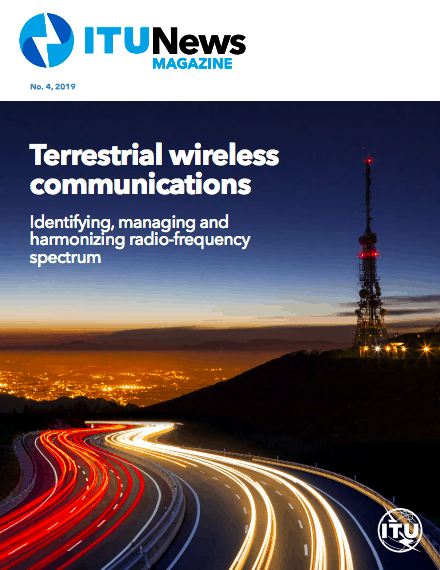
5G is already upon us we must act now to secure its future
Mobile is one of the most far reaching technologies in history and the evolution to 5G is the next essential step to no one being left behind in the digital revolution. 5G is here and we are starting to see how subscribers react to ultra-fast mobile broadband, and critically, how much data they use. But, this is just the beginning, and the full picture of mind-blowing applications and speeds will only be possible when the right allocation of spectrum is made available. How this plays out will have enormous consequences for society, and if ignored, securing a better, 5G-enabled future for all, could risk being set back by a decade of progress.
“5G is not just about more speed or downloading more video — it promises to accelerate the digital transformation of all industries and sectors, and to unleash new waves of innovation that will benefit billions of people.”
In South Korea, according to SK Telecom, 5G data usage has already tripled in comparison with 4G. LG Uplus is seeing 1.3 gigabytes of data used per day per subscriber. This real-life view of how people are using 5G provides stunning evidence for the need to address spectrum planning now, to ensure that this progress is not choked off. The ITU’s role is fundamental, access for everyone to the right spectrum will ultimately define the success of 5G.
5G mobile will drive the digital society
As we all know, 5G is not just about more speed or downloading more video — it promises to accelerate the digital transformation of all industries and sectors, and to unleash new waves of innovation that will benefit billions of people. The mobile industry knows how to make spectrum work for a better future. It has an outstanding record in working with governments and supranational organizations such as ITU, to effectively deploy spectrum to change lives.
But spectrum is finite, and governments need to be sure that this precious resource is maximized, not just financially, but in ways that deliver the greatest benefit to the largest number of citizens.
Over the past 30 years the mobile industry has made good use of its spectrum to make significant contributions to the world.
It has connected over 5.1 billion unique mobile subscribers and almost 9 billion connections, changing the way we communicate, work, manage our health, homes, and entertain ourselves.
In 2018 alone, the mobile industry contributed USD 3.9 trillion to global GDP and added USD 510 billion to public finances. But the advantages brought by the terrestrial mobile industry go far beyond commercial or even contributions to the public purse.
Mobile industry delivers with its spectrum
No-one has done more with available spectrum, nor collaborated more effectively to deliver a better future for everyone. More than two-thirds of the people on the planet are now connected to a mobile network and, for many, mobile is the primary — sometimes only — channel for accessing the Internet and life-enhancing services. Mobile is opening doors to opportunities unimaginable only a few decades ago.
Read the latest edition of ITU News Magazine:

Our industry was the first to commit to the United Nations Sustainable Development Goals in 2016, and continues to lead by connecting less favoured communities, reducing poverty, improving access to health care and education and driving sustainable economic growth. Recently, the GSMA was proud to be awarded the Red Cross Gold medal for our efforts and commitment to humanity.
But we are fundamentally a future-focused industry. Our mission is to enable our customers to do tomorrow what they can’t do today. This means providing 5G networks capable of supporting innovations such as:
• Immersive augmented reality (AR) and virtual reality (VR) educational content that can bring the world’s greatest museums, sites and cultural events to potentially billions of children and adults otherwise excluded from these valuable experiences.
• Radical improvements in health care and the wellness of populations with widespread use of ultra-light, low-power wearables measuring biometrics and providing health advice in real-time.
• Creating smarter, cleaner, safer factories by connecting machinery and robots with mmWave wireless for zero-latency precision control and coordination to increase efficiency and reduce waste.
• Connecting smart cities to manage traffic, resources, power and environment in realtime at massive scale.
5G spectrum can coexist and drive new innovation
Effective allocation of spectrum, especially in the mmWave bands, is critical for these high-speed, high-throughput and low-latency scenarios.
Studies show that 5G will not only coexist alongside other uses but will accelerate the digital transformation of existing industries, and unleash a new wave of innovative solutions to our most pressing global issues.
The mobile industry is a highly-effective ecosystem, 14 million people are directly employed in the industry and 17 million people employed indirectly.
Just as 3G and then 4G networks created new disruptive businesses, from the sharing economy to wearable technology, so 5G will provide the environment for innovations in sustainability, caring for an aging population and ensuring wider and fairer access to opportunity. Allocating sufficient spectrum to international mobile telecommunications (IMT) for 5G stimulates the whole ecosystem, underpins ongoing development of existing networks, and makes sure no-one is left behind in the emerging digital society.
Don’t leave it to chance
This cannot be left to chance, and it cannot be put off. To bring the benefits of mobile services to industry and consumers, operators require timely access to the right amount and type of spectrum, and under the right conditions. In a World Radiocommunication Conference (WRC) year, these decisions need to be made, or we risk a 5–10 year “pause” on progress.
“In a WRC year, these decisions need to be made, or we risk a 5–10 year ‘pause’ on progress.”
To allow for 5G’s full potential, specifications call for 80–100 MHz of contiguous spectrum per operator in the 5G mid-bands and around 1 GHz per operator in the mmWave bands.
The socio-economic case for allocating these bands is strong. Over a 15‑year period, from 2020 to 2034, 5G services that rely on mmWaves will contribute an additional USD 565 billion in global GDP and the USD overall value created by 5G will come from mmWaves.
The ITU has played an instrumental role in enabling the creation of a better world for billions of people through its support of mobile. We all need to build on this success. Mobile operators, governments, other industries and the entire ITU membership need to work hand-in-hand to connect everyone and everything to a better future.
*This article is one of a series commissioned for ‘Terrestrial Wireless Communications’ edition of ITU News Magazine. Views expressed do not necessarily reflect those of ITU.
